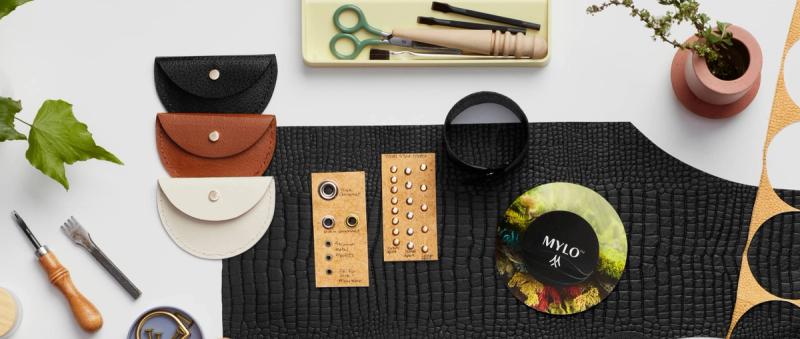FAQ
Mylo™ material is a sustainable leather alternative made from mycelium, the root-like structure of mushrooms, created by the scientists and engineers at Bolt Threads, a material solutions company based in Berkeley, California with manufacturing facilities in The Netherlands.
Products made from Mylo™ material are available directly from our growing network of brand partners. Product availability, release dates, distribution, and points of sale are controlled by partners individually.
Sign up to receive the Mylo Newsletter and get updates on upcoming product launches.The process to make Mylo™ material starts with reproducing what naturally occurs beneath the forest floor. Inside a vertical farming facility powered by 100% renewable energy, fungal cells are mixed with sawdust and organic material to grow dense mycelial networks that rise from the substrate and form soft foam-like mats.
Once mature, the mycelium is harvested and the remaining substrate is composted. Guided by Green Chemistry principles, the mats are processed and transformed into sheets of soft, earthy biomaterial ready for surface texture and finishing by an LWG gold-rated tannery.
For a closer look at the process, visit our Material page.Yes. Mylo™ material is verified vegan by Eurofins Chem-MAP in an independent third-party certification process supported by DNA testing. This extensive verification process ensures the absence of animal-derived materials throughout the entire manufacturing process.
Visit our Impact page to learn more about the benefits of Mylo being 100% animal-free.Products made from Mylo™ material are available directly from our growing network of brand partners. Product availability, release dates, distribution, and points of sale are controlled by partners individually.
Sign up to receive the Mylo Newsletter and get updates on upcoming product launches.Always refer to the original care instructions for more details on how to care for your products made with Mylo™ material.
If properly cared for and stored, products made from Mylo material should last a long time. Our longevity tips and recommendations include storing your products in their original packaging (i.e.: dust bag or box if provided) and stuffing them with crushed paper or retired cloth garments like socks or T-shirts to retain their shape.Always refer to the original care instructions for more details on how to care for your products made with Mylo material.
If properly cared for and stored, products made from Mylo material should last a long time. Our longevity tips and recommendations include storing your products in their original packaging (ie: dust bag or box if provided) and stuffing them with crushed paper, retired cloth garments like socks or t-shirts to retain their shape.Like any new technology, Mylo™ material requires an initial investment to create, produce, and make products from, which means the first pieces to market cost more and often sell out quickly.
The good news: Early demand for products made from Mylo material will help future costs come down. It’s important to us to achieve accessible pricing so that more consumers can choose this highly desirable, sustainable alternative and thus have a wider environmental impact.Mylo™ material was launched in partnership with a group of well-established brands that helped subsidize the massive costs that come with developing a revolutionary new material. Accessibility is 100% our goal as we scale production to meet demand and add more brands to our partner network.
As intended, the early demand created by our initial partnerships is enabling us to increase supply and reduce costs so we can get Mylo in the hands of smaller brands and designers.
Subscribe to the Mylo Newsletter to get updates on new product drops and material availability.Yes. We have partnered with world experts in tanning and dyeing who have been recognized with global sustainability certifications to help build a process designed for human health and safety and low environmental impact.
The processing and finishing chemistries for Mylo™ material are intentionally evaluated and selected using Green Chemistry principles. Mylo material is free of substances of concern such as chromium and DMFa, two of the noxious chemicals used in animal and synthetic leather respectively. We've taken the additional step of gaining OEKO-TEX® STANDARD 100 certification for Mylo, demonstrating the rigor of our assessment process.Absolutely. Our preliminary impact assessments indicate incredible environmental benefits of using Mylo™ material over animal leather. We look forward to sharing more about Mylo's life cycle assessments as we scale production and continue to pursue accurate measurements for comparison.
As of right now, we don't have all of the necessary data available to accurately calculate Mylo™ material's carbon footprint at commercial scale. We regularly conduct life cycle assessments (LCA) of Mylo and use this data to build and optimize our large-scale production process for minimal environmental impact.
We look forward to sharing more information on Mylo’s carbon footprint as we complete our scaling of production. Subscribe to the Mylo Newsletter for updates.Mylo™ material’s composition is predominantly mycelium, and currently contains some lyocell and a water-based polyurethane finish for added strength and durability to ensure Mylo products have a long and useful life. All inputs for Mylo are selected using rigorously applied principles of Green Chemistry for minimal environmental impact compared to animal and fully-synthetic leather production.
For context, animal leathers are also finished with added chemistry — up to 40% of the weight of leather is attributed to fat liquors, plasticizers, and coatings. Synthetic leathers are typically made from synthetic fabrics and polyurethane or PVC coatings, making them 100% plastic.No. There are no genetically-engineered microbes used to manufacture Mylo™ material.

